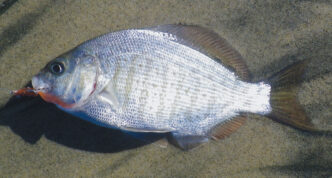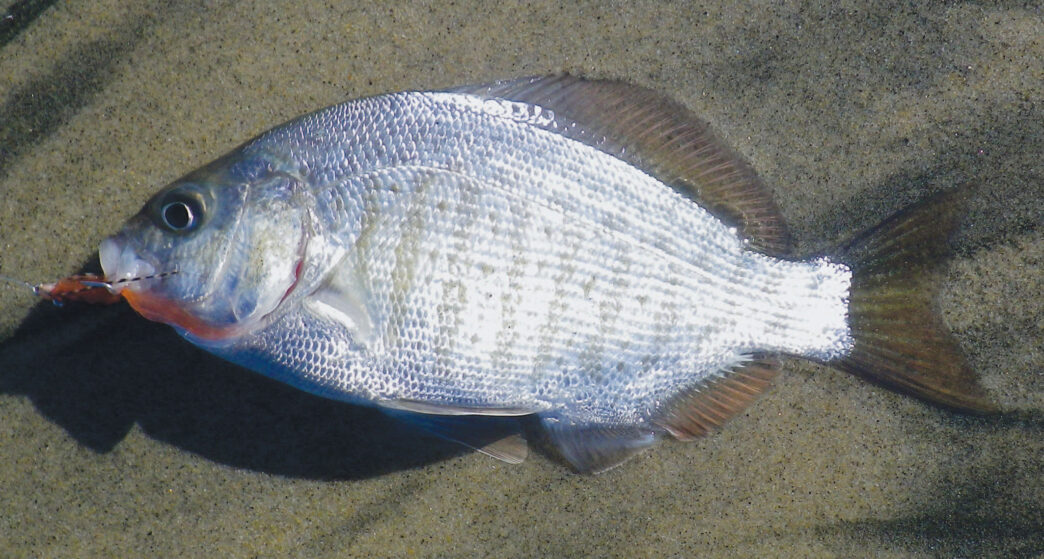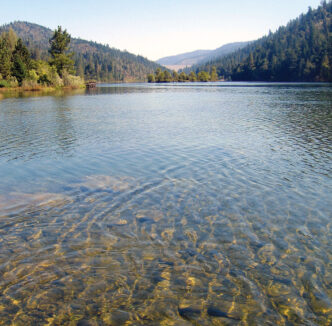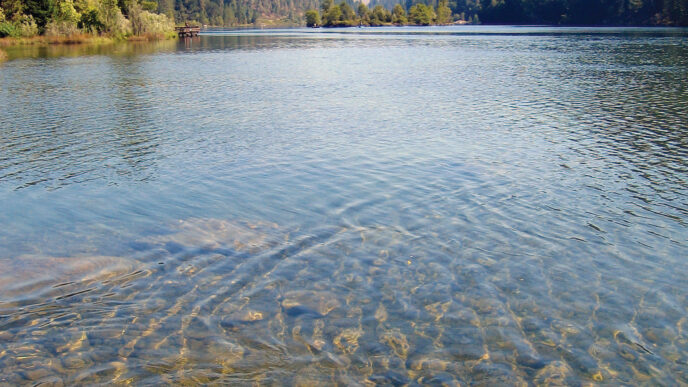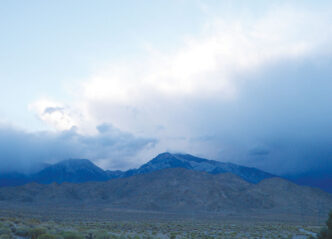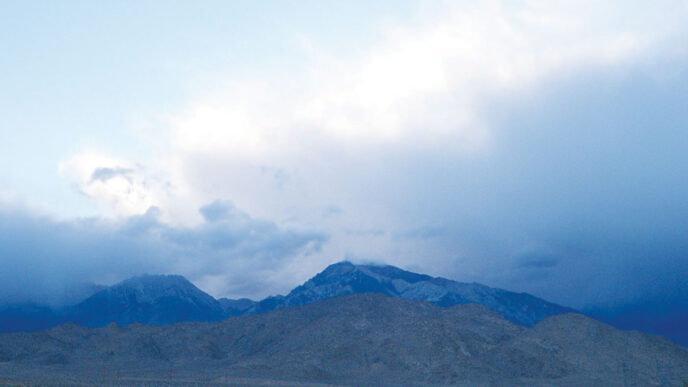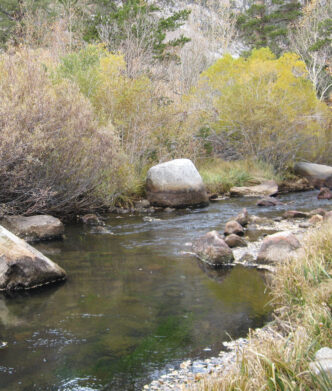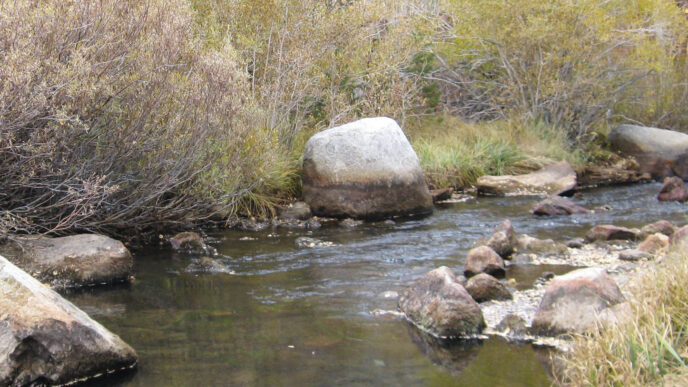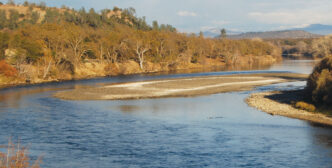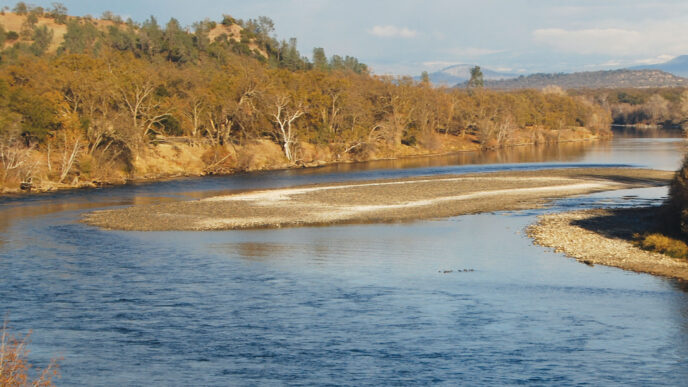Wading an open stretch of beach can present anglers with a challenging set of conditions, even when they’re equipped with stout spinning or conventional tackle. Windswept waves that send clusters of foam dancing across the sand like miniature snow drifts, crashing rollers that pound rocks into billiard-ball smoothness, and undertows that suck the bottom from your feet like a giant vacuum are elements familiar to those who fish the high surf. When you first confront these conditions with fly gear, the environment can seem downright inhospitable. But with proper technique and equipment, fly fishers can successfully fish the surf zone, and off Southern California’s vast and virtually unrestricted beachfront there is a worthy little game fish tailor-made for the fly enthusiast.
In terms of their abundance and readiness to take a variety of offerings, the barred surfperch (Amphistichus argenteus) is the prime species for the fly fisher on Southern California beaches. However, other members of the surfperch clan that you’ll occasionally encounter are the calico surfperch (Amphistichus koelzi), the silver surfperch (Hyperprosopon ellipticum), and the walleye surfperch (Hyperprosopon argentum).
Geographically, barred perch thrive along a considerable stretch of the Pacific coastline. From Bodega Bay, approximately 70 miles north of San Francisco, you can work your way south all the way into the Baja Peninsula to roughly the area around San Quintin and still catch these fish. Though I have experienced very good perch fishing off beaches at both the northern and southern limits of this range (particularly at El Socorro, just a tad south of San Quintin in Baja), here I will limit the discussion to Southern California, encompassing the area from Oxnard south to San Diego.
Compared with most saltwater game fish, surfperch would be considered small. Most fish approximate the size and shape of a freshwater crappie. A three-pound specimen would be considered a prize catch. However, for their size, they are very strong. They have to be, given the nature of the environment in which they must survive. Barred perch may not rip off line like the surf superstars, the corbinas and spotfin croakers, but I’ve had strikes so violent that the rod tip was actually pulled into the water. When hooked, the perch will use their slab-sided bodies to full advantage, providing stubborn resistance until you finally manage to slide them up on the wet sand.
Barred perch can be caught all year long, but the best months usually are from December through April. Some of the larger fish are taken in January, when females come into the surf from deeper water in preparation for spawning. They also come in search for food, primarily in the form of sand crabs, which is the principal dietary source for both perch and corbinas.
Tidal Action
When fishing the surf, you’ll find that periods of optimum productivity are closely tied to tidal phases, and you should plan your outings accordingly. Tidal currents must be reckoned with, because they play such an important role in the availability of the fish’s food sources. Strong tidal currents churn the bottom, stirring up food items such as sand crabs and sand worms. Like other predators, the perch tune into these opportunities, and that is why the best fishing is typically during periods of incoming and outgoing tides.
Reading the Surf
To casual beachgoers, most stretches of shore may look relatively the same, but experienced surfers, as well as veteran surf fishers, know that is not the case. As is true with all species, the behavior of surfperch is closely associated with the nature of their habitat. So when you begin to learn about the physical makeup of their environment, you increase your chances of successful encounters.
Basically, reading the surf involves the ability to monitor closely the characteristics of wave action. This, in turn, will enable you to make a fairly good estimate of what the bottom configuration is like. The key to all this is that waves break over shallow areas. In contrast, they tend to roll over deeper areas such as depressions and troughs along the bottom without breaking. Essentially, then, the behavior of a wall of water as it makes its way to shore gives an indication of the type of bottom that lies below. So if you observe what appears to be a relatively flat area of water rushing in toward shore, with waves breaking on either side of it, that’s a sign that there is a depression in the bottom directly under the flat section of water.
These deeper pockets are generally good areas into which to direct your casts, because bait is often concentrated there. Tiny marine organisms such as sand crabs and small baitfish that are unable to swim against strong tidal currents are eventually swept into the calmer water these deeper areas provide.
Another feature of the beach you should note is the degree to which it slopes toward the water. As waves roll toward shore, they begin to break. By noting the distance of the break from the shoreline, you can determine if the beach slopes sharply or gradually. Obviously, you can also establish this by wading into the water. Where bottom visibility is compromised, however, this isn’t a prudent procedure, because you can suddenly find yourself in water that is much deeper than you anticipated. If you’re unfamiliar with an area, before you venture forward into the surf, take a few moments to observe the breaking patterns of the waves. On steeply sloping beaches, waves break practically at the water’s edge, and there are often troughs close to the shore, sometimes only a few feet from where the water laps the sand. Direct your casts into these troughs, because if perch are in the area, this is where they are most likely to congregate.
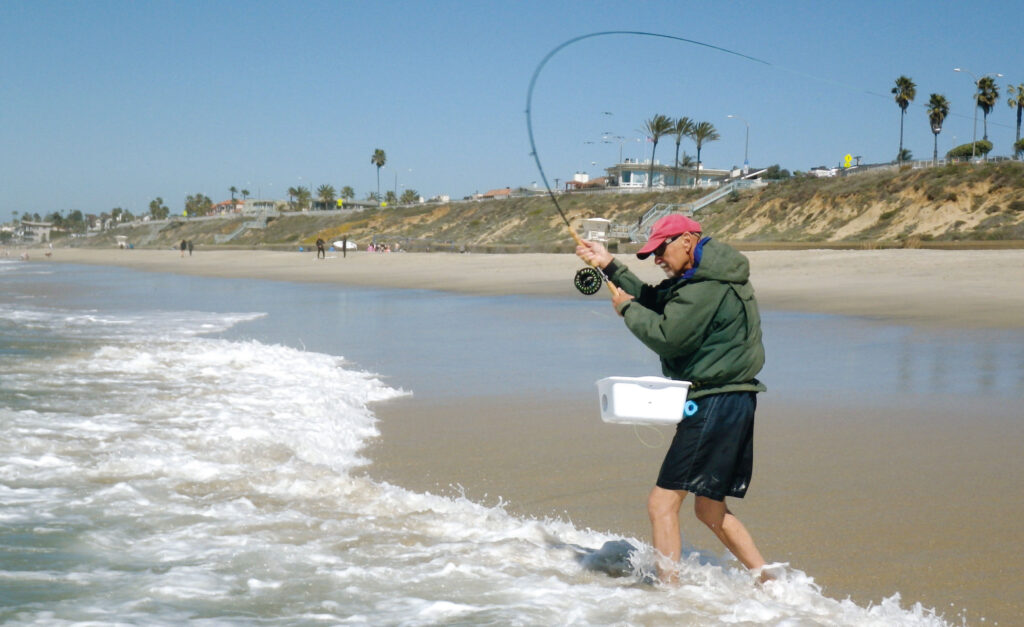
Casting into crosscurrents can also be productive. These are easy to detect, because the surface water disturbance is plainly visible. When the water surges are strong, the converging currents slap together and form wavelets that are perpendicular to the beach. Sand crabs and small baitfish can get tossed around in this turbulence, and the perch are quick to dart in and take advantage of prey that has difficulty evading their advances.
However, even if you have found these areas, it is unrealistic to expect that conditions will remain the same. Changing tides, winds, and currents, as well as storms at sea, constantly alter the configuration of the beach. This can even apply during the course of one tidal phase. So regardless of how good a particular stretch may look, if repeated casts bring no strikes, start walking the beach and try to cover as much shorefront as possible.
Appropriate Tackle
Obviously, for fish this size, beefy saltwater rod and reel combinations aren’t necessary in the Southern California surf. An 8-weight outfit will be at the heavy end of the scale and will see you through most of the conditions you are likely to encounter on Southland beaches. If the wind is down and the surf is relatively calm, you’ll have more fun with a 6-weight. In the last few years, I’ve been fishing lightweight 4-weight, 5-weight, and 6-weight two-handed rods with Skagit lines and sink tips. This setup allows you to Skagit cast when the surf is calm or simply overhead cast.
Despite the fact that water depths will seldom be more than 8 to 10 feet, given the water turbulence, you want a line that will get the fly close to the bottom, where the perch do most of their feeding. For single-handed rods, I prefer sinking shooting heads. The leader setup is simplicity itself. All you really need is a single section of class tippet — 8-pound to 12-pound test is a good range. Make these short, about 3 to 3-1/2 feet. This will insure a good sink rate, and you will have fewer problems casting into the wind.
Fly Patterns
Since sand crabs make up most of the food source for barred perch in the surf, it makes sense to use flies that simulate these small crustaceans. But over the years, I’ve found that attempts at convincing simulations are not necessary. When I first started fly fishing for these perch some fifty years ago, my flies were simple Comet and Woolly Worm patterns. Then, after a few bonefish trips to the Bahamas, I started tossing Crazy Charlies, and the perch loved them. A great all-around perch pattern is a Clouser that’s an inch and a half to two inches long, tied on hooks ranging from size 1 to size 4.
One of my favorite materials for these patterns is Steve Farrar’s Flash Blend. Mullet brown and bleeding gray provide a good simulation of the sand crab’s coloration, while attractor colors such as pink, bleeding orange, redfish, and bleeding yellow have produced good results. (If you travel a considerable distance west, you’ll find the bleeding orange does well on Hawaiian bonefish). Regardless of the pattern you choose to present, make sure your surf fly is both durable and non-fouling.
Auxiliary Gear
In the surf’s whirlpool environment, you definitely have to be concerned with line management. If you simply allowed the line to fall into the water, you would have a tangled mess that would probably cause you to stop fishing. To avoid this, by all means use a stripping basket. An example of a well-designed commercially available basket is Sea Level’s Bucket Shooter. A model with holes in the base is what you want for the surf, so if water splashes in, it will quickly drain out. Of course, you can always make your own stripping basket from a variety of plastic containers, such as dishpans and small wastepaper baskets.
Don’t let the media images fool you. With the exception of the summer and early fall, the Southern California surf can be quite chilly. During the winter months, a pair of chest-high waders is definitely recommended.
One final cautionary note in this regard. Always be especially careful when fishing the surf. It is neither necessary nor particularly safe to wade out over your knees. You could easily step in a hole, or the undertow could knock you down. Most surf-zone species are found relatively close to the beach. Learn to cast 60 feet into the wind, and you will generally have all the distance you need to fish effectively.
Be careful, but don’t be intimidated by the conditions. With a little practice and attention to your surroundings, you’ll be in for some fun times with your fly gear. Just be sure to bring some quarters for the parking meters at most Southern California beaches and be sure to have a current fishing license on your person.
Because Southern California has vast stretches of shoreline readily accessible to the public, surf fishing is something that you can easily undertake on your own. Working your way north from the Mexican border, you’ll find good stretches of open beach at the following locations: the shorefront south of Imperial Beach Pier; Silver Strand Beach on Coronado Island; Sunset Cliffs; Bird Rock, just south of La Jolla; Torrey Pines; Cardiff and San Elijo State Beaches; San Onofre (a short distance north of the nuclear power plant); San Clemente; Laguna Beach; Huntington State Beach; Bolsa Chica State Beach; Sunset Beach, Alamitos State Beach; Royal Palms State Beach; my old home waters of Redondo, Hermosa, Manhattan, and El Segundo Beaches; Topanga Beach; Malibu Beach (watch your back cast — you don’t want to snag a movie star); Point Dume State Beach; Leo Carrillo State Beach; Point Mugu; and Hollywood Beach, off Oxnard.



